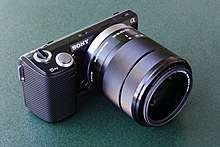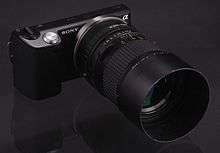Sony NEX-5
 | |
| Overview | |
|---|---|
| Type | Mirrorless interchangeable lens camera |
| Lens | |
| Lens | Sony E-mount |
| Sensor/Medium | |
| Sensor | 23.4 × 15.6 mm Exmor APS-C HD CMOS Sensor |
| Maximum resolution | 4592 × 3056 (14.2 megapixels) |
| ASA/ISO range | Auto, 200, 400, 800, 1600, 3200, 6400, 12800 |
| Storage | Memory Stick Pro Duo, Pro-HG Duo, SD, SDHC, SDXC |
| Focusing | |
| Focus modes | Contrast-detection auto-focus, 25 multi-point, Centre-weighted, Flexible Spot |
| Exposure/Metering | |
| Exposure modes | Intelligent Auto, Program, Aperture priority, Shutter priority, Manual, Scene modes |
| Exposure metering | Multi-segment, Center-weighted, Spot |
| Metering modes | Multi-segment, Centre-weighted, Spot |
| Flash | |
| Flash | External flash (bundled) |
| Shutter | |
| Shutter speed range | 1/4000 - 30 sec, BULB |
| Continuous shooting | 2.3 frame/s, 7 frame/s in speed priority mode |
| Viewfinder | |
| Viewfinder | Optional external optical viewfinder |
| General | |
| Rear LCD monitor | 3.0 in (76 mm) XtraFine TruBlack LCD, 920,000 pixels |
| Battery | NP-FW50, InfoLITHIUM, 7.2 V, 1080 mAh, 7.7 Wh, Lithium-Ion rechargeable battery |
| Dimensions | 111 mm × 59 mm × 38 mm |
| Weight | Approx. 287 g (10.1 oz) (camera body, card and battery) |
The Sony NEX-5 is a digital camera launched on 11 May 2010.[1] It is a mirrorless interchangeable lens camera with the body of a common point-and-shoot camera but with a sensor size (APS-C) comparable to that of some digital single-lens reflex cameras. Its major competitors in the market are the cameras based on the micro 4/3 standard created by Panasonic and Olympus, and a few low end Canon, Nikon, and even Sony α DSLRs.[2] The NEX-5 shoots 14.2 megapixel stills and has a 7 frame/s continuous shotmode.[3] It has the capability to shoot 1920×1080i at 60 frame/s in AVCHD or 1440×1080p at 30 frame/s in MPEG4. The NEX-5 was replaced by the 16 megapixel NEX-5N in August 2011.
Features
The NEX-5 has features found in SLR cameras but also some that are normally found in point and shoots. The body of the NEX-5 is made out of a magnesium alloy that separates the NEX-5 from the less expensive polymer NEX-3. Also different from the NEX-3 is video quality. The NEX-5 can shoot in AVCHD 1080/60i HD. There is a 7 frame/s continuous shot mode, with autofocus disabled after the first frame. The APS-C sized sensor has an ISO sensitivity up to 12,800.[3] The camera software has special features like twilight mode and sweep panorama. The latter lets the photographer sweep across a city-sky line or similar long view and have the photos automatically stitched into a JPEG image on camera.[4]
Lenses

The NEX-5 along with its sister, the NEX-3, and also the Sony Handycam NEX-VG10 use a new lens mount system developed by Sony for NEX series and known as the Sony E-mount. Initially, there were three available lenses: an all-purpose 18–55 mm lens, an ultra wide pancake 16 mm lens, and a wide range 18–200 mm E-mount lens.[5]
With the post-November 2010 firmware version 3 installed, and by using the (roughly 200 USD) Sony LA-EA1 adapter, the NEX series of cameras is able to electronically control the aperture and autofocus of Sony SSM/SAM A-mount lenses, and control the aperture of the other Sony/Minolta A-mount lenses with manual focus only. The (roughly 400 USD) Sony LA-EA2 adapter also supports autofocus with screw-drive A-mount lenses, firmware version 5 is required for this adapter.

Other third-party mechanical tube adapters are also available. These adapters enable the use of Canon FD-mount, Canon EF-mount (without aperture control), Contax G, M42 screw mount, Konica Hexanon AR-mount, Minolta SR-mount (MC/MD), Leica M and screw mount, Nikon F-mount (non-G), Pentax K-mount (non-DA), T2 screw mount and Minolta/Konica Minolta/Sony A-mount lenses. The E-mount flange register is so short that it is possible to mount 45 mm or longer-focal-length non-focusing enlarging lenses on the NEX body, with the use of an intermediate focusing helicoid behind them.
Certain third-party mechanical adapters also provide circular control rings that provide some mechanical control of the aperture of Nikon G, Pentax DA and Canon EF lenses, as these do not have a mechanical aperture control ring on their lens barrels.
Model definitions
The complete model number of NEX-3/NEX-5 series may include letter(s) at end. The definitions are:
- C: Not compatible with Eye-Fi function (NEX-3C and NEX-5C only)
- A: Supplied with E 2.8/16mm (SEL-16F28)
- D: Supplied with E 2.8/16mm (SEL-16F28) and E 3,5-5,6/18-55mm OSS (SEL-1855)
- H: Supplied with E 3.5-6.3/18-200mm OSS (SEL-18200)
- K: Supplied with E 3.5-5.6/18-55mm OSS (SEL-1855)
- L: Supplied with E 3.5-5.6/16-50mm OSS (SEL-1650)
- B: Body color is black
- /N: Body color is gold (NEX-5D/N, Japan only)
- /P: Body color is pink (NEX-3D/P, Asia only)
- R: Body color is red
- S: Body color is silver
- /T: Body color is brown (NEX-3D/T, Asia only)
- 50i: 50 frames interlaced model
- 60i: 60 frames interlaced model
For example, NEX-5CK/B 50i is a NEX-5 supplied with E 18-55 mm zoom lens, not compatible with Eye-Fi function, body color black, and with 50i (not 60i) video support.
See also
References
- ↑ https://www.youtube.com/watch?v=lzG_ZPbJGlg
- ↑ http://reviews.cnet.com/digital-cameras/sony-alpha-nex-5/4505-6501_7-34098374.html?tag=contentMain;contentBody;1r
- 1 2 http://www.sonystyle.com/webapp/wcs/stores/servlet/ProductDisplay?catalogId=10551&storeId=10151&langId=-1&productId=8198552921666192716
- ↑ http://www.sony.co.uk/hub/nex-compact-camera-system/range/nex-5 NEX-5
- ↑ "E-mount lens: Sony Asia". Retrieved 2011-02-09.
External links
| Wikimedia Commons has media related to Sony NEX-5. |
- SonyStyle product description – official Sony website
- Sony UK product presentation – official Sony UK website
- DP Review (Digital Photography Review) – June 2010, an in-depth review of the two cameras
- Pop Photo Review – May 2010 review
Sony E-mount MILC timeline | |||||||||||||||||||||||||||||||||||||||||||||||||||||||||||||||||||||||||||||||||||||||||||||||||||||||||||||||||||||||||||||||||||||||||||||||||||||||||||||||||||||||||||||||||||||||||||||||||||||||||||||||||||||||||||||||||||||||||||||||||||||||||||||||||||||||||||||||||||||||||||||||||||||||||||||||||||||||||||||||||||||||||||||||||||||||||||||||||||||||||||||||||||||||||||||||||||||||||||||||||||||||||||||||||||||||||||||||||||||||||||||||||||||||||||||||||||||||||||||||||||||||||||||||||||||||||||||||||||||||||||||||||||||||||||||||||||||||||||||||||||||||||||||||||||||||||||||||||||||||||||||||||||||||||||||||||||||||||||||||||||||||||||||||||||||||||||||||||||||||||||||||||||||||||||||||||||||||||||||||||||||||||||||||||||||||||||||||||||||||||||||||||||||||||||||||||||||||||||||||||||||||||||||||||||||||||||
|---|---|---|---|---|---|---|---|---|---|---|---|---|---|---|---|---|---|---|---|---|---|---|---|---|---|---|---|---|---|---|---|---|---|---|---|---|---|---|---|---|---|---|---|---|---|---|---|---|---|---|---|---|---|---|---|---|---|---|---|---|---|---|---|---|---|---|---|---|---|---|---|---|---|---|---|---|---|---|---|---|---|---|---|---|---|---|---|---|---|---|---|---|---|---|---|---|---|---|---|---|---|---|---|---|---|---|---|---|---|---|---|---|---|---|---|---|---|---|---|---|---|---|---|---|---|---|---|---|---|---|---|---|---|---|---|---|---|---|---|---|---|---|---|---|---|---|---|---|---|---|---|---|---|---|---|---|---|---|---|---|---|---|---|---|---|---|---|---|---|---|---|---|---|---|---|---|---|---|---|---|---|---|---|---|---|---|---|---|---|---|---|---|---|---|---|---|---|---|---|---|---|---|---|---|---|---|---|---|---|---|---|---|---|---|---|---|---|---|---|---|---|---|---|---|---|---|---|---|---|---|---|---|---|---|---|---|---|---|---|---|---|---|---|---|---|---|---|---|---|---|---|---|---|---|---|---|---|---|---|---|---|---|---|---|---|---|---|---|---|---|---|---|---|---|---|---|---|---|---|---|---|---|---|---|---|---|---|---|---|---|---|---|---|---|---|---|---|---|---|---|---|---|---|---|---|---|---|---|---|---|---|---|---|---|---|---|---|---|---|---|---|---|---|---|---|---|---|---|---|---|---|---|---|---|---|---|---|---|---|---|---|---|---|---|---|---|---|---|---|---|---|---|---|---|---|---|---|---|---|---|---|---|---|---|---|---|---|---|---|---|---|---|---|---|---|---|---|---|---|---|---|---|---|---|---|---|---|---|---|---|---|---|---|---|---|---|---|---|---|---|---|---|---|---|---|---|---|---|---|---|---|---|---|---|---|---|---|---|---|---|---|---|---|---|---|---|---|---|---|---|---|---|---|---|---|---|---|---|---|---|---|---|---|---|---|---|---|---|---|---|---|---|---|---|---|---|---|---|---|---|---|---|---|---|---|---|---|---|---|---|---|---|---|---|---|---|---|---|---|---|---|---|---|---|---|---|---|---|---|---|---|---|---|---|---|---|---|---|---|---|---|---|---|---|---|---|---|---|---|---|---|---|---|---|---|---|---|---|---|---|---|---|---|---|---|---|---|---|---|---|---|---|---|---|---|---|---|---|---|---|---|---|---|---|---|---|---|---|---|---|---|---|---|---|---|---|---|---|---|---|---|---|---|---|---|---|---|---|---|---|---|---|---|---|---|---|---|---|---|---|---|---|---|---|---|---|---|---|---|---|---|---|---|---|---|---|---|---|---|---|---|---|---|---|---|---|---|---|---|---|---|---|---|---|---|---|---|---|---|---|---|---|---|---|---|---|---|---|---|---|---|---|---|---|---|---|---|---|---|---|---|---|---|---|---|---|---|---|---|---|---|---|---|---|---|---|---|---|---|---|---|---|---|---|---|---|---|---|---|---|---|---|---|---|---|---|---|---|---|---|---|---|---|---|---|---|---|---|---|---|---|---|---|---|---|---|---|---|---|---|---|---|---|---|---|---|---|---|---|---|---|---|---|---|---|---|---|---|---|---|---|---|---|---|---|---|---|---|---|---|---|---|---|---|---|---|---|---|---|---|---|---|---|---|---|---|---|---|---|---|---|---|---|---|---|---|---|---|---|---|---|---|---|---|---|---|---|---|---|---|---|---|---|---|---|---|---|---|---|---|---|---|---|---|---|---|---|---|---|---|---|---|---|---|---|---|---|---|---|---|---|---|---|---|---|---|---|---|---|---|---|---|---|---|---|---|---|---|---|---|---|---|---|---|---|---|---|
| |||||||||||||||||||||||||||||||||||||||||||||||||||||||||||||||||||||||||||||||||||||||||||||||||||||||||||||||||||||||||||||||||||||||||||||||||||||||||||||||||||||||||||||||||||||||||||||||||||||||||||||||||||||||||||||||||||||||||||||||||||||||||||||||||||||||||||||||||||||||||||||||||||||||||||||||||||||||||||||||||||||||||||||||||||||||||||||||||||||||||||||||||||||||||||||||||||||||||||||||||||||||||||||||||||||||||||||||||||||||||||||||||||||||||||||||||||||||||||||||||||||||||||||||||||||||||||||||||||||||||||||||||||||||||||||||||||||||||||||||||||||||||||||||||||||||||||||||||||||||||||||||||||||||||||||||||||||||||||||||||||||||||||||||||||||||||||||||||||||||||||||||||||||||||||||||||||||||||||||||||||||||||||||||||||||||||||||||||||||||||||||||||||||||||||||||||||||||||||||||||||||||||||||||||||||||||||